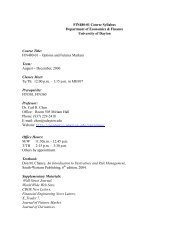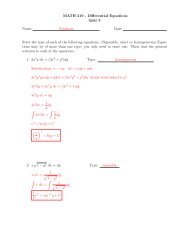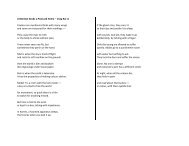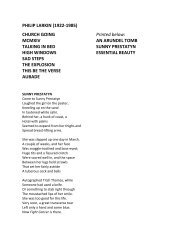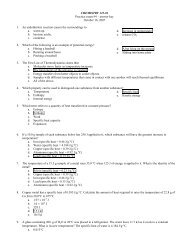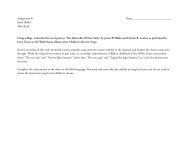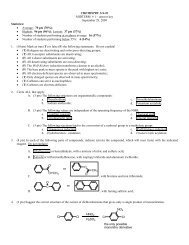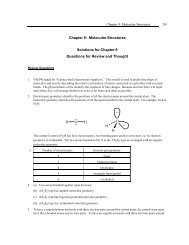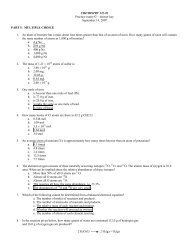Chap 26
Chap 26
Chap 26
You also want an ePaper? Increase the reach of your titles
YUMPU automatically turns print PDFs into web optimized ePapers that Google loves.
MONEY, BANKS, AND THE FEDERAL RESERVE 229<br />
3. How Banks Create Money<br />
A money creation experiment. The process through which banks “create money” can be a dark and<br />
mysterious secret to the students. Indeed, even though the text contains a superb description of the<br />
process, students still manage to end up confused.<br />
The first prerequisite to students understanding the process is that they be comfortable with balance<br />
sheets shown in the form of T-accounts, and it is well worth spending time on them to make sure<br />
students understand what they are and what they show. This will be the first time some students have<br />
ever had to interpret a balance sheet, and it is key that they understand that assets are what are<br />
owned, liabilities are what are owed, by the institution for which the balance sheet is constructed;<br />
and that the two sides must balance.<br />
Mark Rush (our study guide author and supplements czar) tackles the problem of getting students to<br />
understand bank money creation head-on by (again) involving the class in a demonstration. Prepare<br />
by decorating a piece of green paper with currency-like symbols. (For instance, Mark draws a seal and<br />
around it write “In Rush We Trust.” You may write the same slogan, but substituting your name for<br />
his probably will be more effective; an alternative is to use “play money”). Label this piece of paper a<br />
“$100 bill.”<br />
In class use one of the students by handing him the bill. Tell him that he has decided to deposit it in<br />
his bank and ask him his bank’s name. On the chalkboard draw a balance sheet for the bank with<br />
deposits of $100, reserves of $10, and loans of $90. Tell the students that the required reserve ratio is<br />
10 percent, so this bank currently has no excess reserves. Now, instruct the student to deposit the<br />
money in his bank, which coincidentally happens to be run by the student next to him. Show the<br />
class what happens to the balance sheet and how the bank now has excess reserves of $90.<br />
Clearly the “banker” will loan these reserves to the next student in the class, who wants a $90 dollar<br />
loan so she can take a bus ride to some nearby dismal location. (Being located in Gainesville, Florida,<br />
Mark picks on the city of Stark, home to Florida’s electric chair and a town with an apt name.)<br />
When the loan takes place, rip the $100 bill so that only about nine tenths of it is given as the loan.<br />
This student pays the money to Greyhound—coincidentally the next student. Ask the name of<br />
Greyhound’s bank and draw an initial balance sheet for this bank identical to the initial balance sheet<br />
of the first bank. Greyhound deposits the money in the bank—the next student in the row.<br />
Work with the balance sheets to show what happens to the first bank and what happens to the<br />
second bank. Clearly the first one no longer has excess reserves but the second bank now has $81 of<br />
excess reserves ($90 of additional deposits minus $9 of required reserves). The second bank will make<br />
a loan, which you can act out with more students in the class, again ripping off nine tenths of the<br />
remaining bill. Work through the point where the second loan winds up deposited in a third bank<br />
and then stop to take stock. At this point the quantity of money has increased by $90 in the second<br />
bank and $81 in the third, for a total increase—so far—of $171. The students will see that this<br />
loaning and reloaning process is not yet over and that the quantity of money will increase by still<br />
more. Moreover (and more important) the students will grasp how banks “create money.”<br />
4. The Federal Reserve System<br />
Conspiracy theory of the Fed. Some students will have heard about a “conspiracy theory of the Fed.”<br />
This theory, advanced by the ignorant, the misinformed, or the deceitful, is that the commercial<br />
banks own the Fed, which is run solely to benefit the banks to ensure that they earn large profits.<br />
Point out that commercial banks do indeed own the Fed—they own all the stock issued by the Fed.<br />
But Fed stock is not like shares in General Electric or Microsoft. The dividend on the Fed’s stock is<br />
fixed at 6 percent of the purchase price, and the stock cannot be sold in a marketplace. So this stock<br />
is a lousy investment<br />
What privileges come with the stock? Commercial banks elect six of the nine directors of their Federal<br />
Reserve Regional bank; each commercial bank’s votes are proportional to the stock it owns. But the




